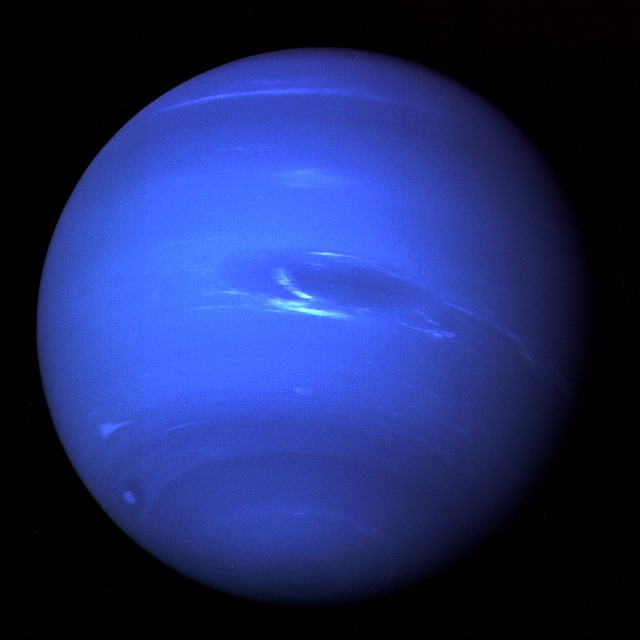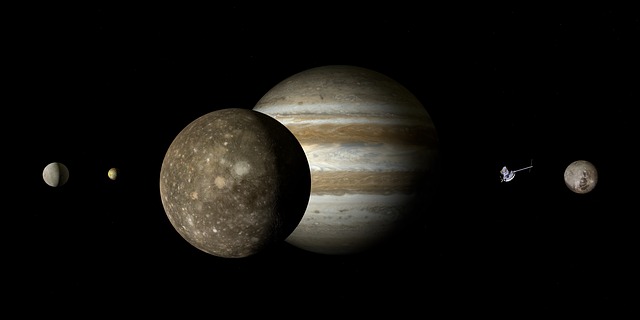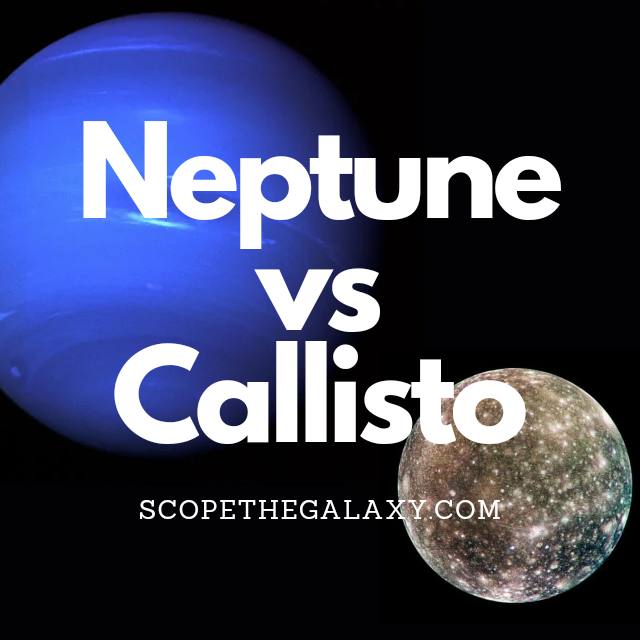*This post may contain affiliate links. This means we may make a commission if you purchase an item using one of our links*
The main differences between Neptune and Callisto is that Neptune is an ice based gas giant whilst Callisto is a low density moon that orbits Jupiter, Neptune is the 4th biggest planet with a diameter of 49,244km whilst Callisto is the 3rd largest moon with a diameter of 4,820.6km and Neptune has the strongest winds in the solar system at 2,000 km/h whilst Callisto is amongst the most cratered entities in our solar system.
There are various other differences between the two so, continue reading for a more thorough breakdown of both celestial bodies along with a more detailed breakdown of their similarities and differences.
What Is The Planet Neptune?
Table of Contents

Neptune is the 8th farthest planet from the Sun and ranks among the bigger planets in our solar system. As the 8th farthest planet from the Sun, it does take Neptune a very long time to complete 1 orbital around the Sun.
This takes 165 years to complete which in comparison to the 16 hour 1 full spin around the axis is a massive difference.
In regards to its composition, Neptune is mostly made up of a thick swath of water closer to the center, methane, ammonia, hydrogen and helium molded around its Earth sized core.
As a result of the excess amount of methane and the inclusion of another undiscovered element within the atmosphere, Neptune’s color is a far deeper blue than the likes Uranus, which also has an abundantly methane based atmosphere.
The planet is 49,244km in diameter, making it roughly 4 times Earth’s diameter Earth, and would allow around 57 Earths to fit inside it. This also makes Neptune the 4th largest planet in our solar system.
Neptune is very cold mostly down to its distance from the Sun, where its atmospheric temperature sits between-220 to -230 degrees Celsius. Its core is far hotter coming in at 5,100 degrees Celsius and is the very likely cause for the liquid water present within the planet
Subsequently, the erratic temperature and gaseous composition of Neptune, is what constitute towards its turbulent behavior.
In fact Neptune has the fasted winds in our solar system, producing some that eclipse speeds of 2,000km per hour. The fastest winds on Earth would only be a fifth of these speeds at most.
At this moment in time we have discovered 14 moons orbiting Neptune and have also observed 5 thinner rings surrounding the ice giant.
What Is The Moon Callisto?

Callisto is one of the large moons orbiting Jupiter, the outermost of the Galilean moons, first discovered on 7th January 1610. The surface of this icy world is frozen, but scientists believe an underground ocean could reside beneath the ice.
Even if there’s water on Callisto, it won’t necessarily hold life because the surface is so old. Scientists will need to conduct more research into the moon before determining whether this is a likely possibility.
The ESA’s JUICE (Jupiter Icy Moon Explorer) mission is focused on the three ice moons of Jupiter. It is expected to arrive in 2030 and will focus on learning more about the environment of each, as well as their potential for hosting life.
Scientists estimate that Callisto is around 4.5 billion years old (the same age as Jupiter), and its average distance from the Sun is approximately 778 million km. It has a diameter of 4,820.6km, which makes it similar in size to the planet Mercury, and the average temperature is a frigid minus 139.2 degrees Celsius.
Callisto takes seven days to orbit its planet at an average distance of 1,880,000km, and it is tidally locked, meaning the same side of it always faces Jupiter. But this moon experiences less tidal influence than the other Galilean moons because it lies in the orbit of Jupiter’s primary radiation belt.
The name of this moon is derived from the stories of Greek myth. Callisto was the nymph who had an affair with Zeus, the King of the Gods. Upon hearing this news, Zeus’ wife Hera turned Callisto into a star and placed her in the Ursa Major constellation. Interestingly, every moon of Jupiter is named after a Greek figure who Zeus seduced.
Callisto may be the third biggest moon and similar in size to the planet Mercury, but it only has a mass of 107,593,737,963.819 billion kg. That may sound like a lot, but it’s only ⅓ the mass of the similarly sized Mercury.
You may wonder why scientists classify Callisto as a “moon” rather than a planet if it’s almost the same size as Mercury. The reason is simple; planets must orbit the sun, but Callisto orbits one of the planets.
The composition of this frigid world is around 60% rock and iron and 40% ice. The moon has roughly equal amounts of rock and ice, plus the potential for water below the surface. There are also traces of carbon dioxide, organic compounds, and silicates.
This moon is one of the oldest landscapes in the Milky way and the most heavily cratered body in our system. However, scientists believe this could now be a “dead” moon as there are no longer any signs of volcanism or plate tectonics on its surface.
Similarities Between Neptune And Callisto
There are a few similarities that Neptune and Callisto share, which in this case includes the following:
- Both are a spherical shape.
- Both have a hotter core.
- Both are part of the same solar system.
- Neither have tectonic plates.
- Both orbit another object.
Differences Between Neptune And Callisto
In regards to the differences between the two, they include the following:
- Neptune is bigger with a diameter of 49,244km compared to Callisto’s diameter of 4,820.6km.
- Neptune has a magnetosphere whilst Callisto does not.
- Neptune has 14 moons orbiting it whilst Callisto has 0 objects orbiting it.
- Callisto orbits Jupiter in an elliptical pattern whilst Neptune orbits the Sun in an less drastic elliptical pattern.
- Callisto is tidally locked to Jupiter whilst Neptune isn’t tidally locked to any other object.
- Neptune has an atmosphere composed of hydrogen, helium and methane whilst Callisto has a very thin carbon dioxide based exosphere.
- Callisto is one of the most heavily catered entities in our solar system where it has 142 named craters with a lot more smaller one scattered throughout the moon whilst Neptune is an ice based gas giant therefore, it doesn’t have a solid surface for craters to form.
- A day on Callisto takes 17 days whilst Neptune completes a day in 16 hours.
- Callisto’s density is 1.83 g/cm³ whilst Neptune is the most dense gas giant at 1.64 g/cm³
- In regards to axial tilt, Neptune’s is 28 degrees whilst Callisto’s is practically 0 degrees.
- Neptune’s average temperature is -220 to -230 degrees Celsius whilst Callisto’s temperature is -139.2 degrees Celsius.
- As for mass, Callisto’s is 1.07 x 10^23 kg whilst Neptune’s mass is 1.024 × 10^26 kg.
- Neptune is an ice based gas giant whilst Callisto is a low density terrestrial entity.
- Neptune has 5 rings surrounding it whilst Callisto has 0.
- Neptune’s gravitational strength is 11.15 m/s² whilst Callisto’s is 1.236 m/s².
- Neptune orbits the Sun in 165 years whilst Callisto orbits it in 12 years.
- Neptune has the fastest wind speeds in our solar system where they can reach numbers of upto 2,000 km/h.
Summary
Although there are similarities between Callisto and Neptune such as the fact both have a somewhat elliptical orbit and both are part of the same solar system, there really aren’t much else that they share.
Whether it be in regards to size, mass, temperature, length of their day, axial tilt and more, Neptune and Callisto are simply designed to function very differently from another and as a result don’t really fall under the same bracket of celestial entities within our solar system.

